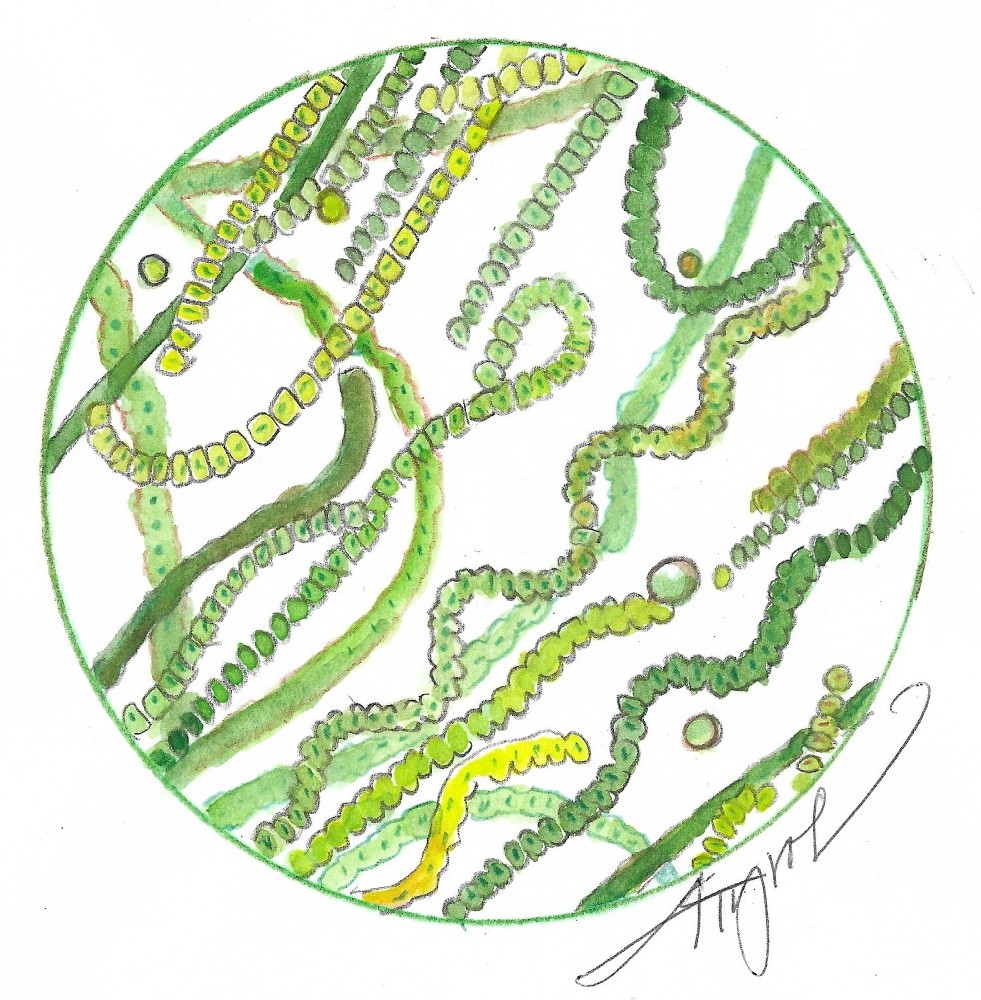
Perhaps you saw the flyers at your town office or a warning sign posted at your favorite swimming hole. The smell might have driven you home, but maybe you crept closer – unable to see anything wrong but unnerved by the deserted shoreline on such a hot and inviting day. Cyanobacteria have become a detrimental presence in New England’s lakes and rivers, erupting into toxic blooms that choke out other forms of life. Yet while we are familiar with their destructive side, few people know about the great favor they once bestowed on our young and hostile planet. These single-celled beings are some of our oldest living relatives, and the three-billion-year story of their existence is one worth listening to.
The early Earth was an oxygen-less world shaded by dense volcanic clouds. The first forms of life were single-celled and anaerobic, meaning they did not need oxygen to survive. Instead, these organisms used energy from a variety of alternative sources, including sulfur and methane. The energy output of these substances is far lower than oxygen – the equivalent of starting your day with green tea instead of coffee – which constrained the complexity of life to single-celled forms. A billion quiet years went by in this anaerobic world. Our planet could have turned out quite differently had cyanobacteria not come along.
Seen through a microscope, single-celled cyanobacteria glitter like emeralds due to their unique invention: photosynthesis. This allows them to spin sunlight into sugar using only water and carbon dioxide, with oxygen produced as a waste product. As cyanobacteria spread throughout the ancient oceans, they increased oxygen levels, ushering in a complete overhaul of Earth’s atmosphere. This “Great Oxidation Event” set the stage for the emergence of complex life. Modern chloroplasts in plants are direct descendants of these early cyanobacteria, and they live on in every fern, grass, and leaf to create the lush green of a New England summer.
Cyanobacteria are still alive and thriving today, and their growth requirements are simple. Aside from water, sunlight, and carbon dioxide, they need the elements nitrogen and phosphorous. These nutrients are naturally scarce in lakes and rivers, which keeps the cyanobacterial population in check. Toxic blooms occur when a surplus of these elements is delivered to waterways, causing explosive growth and often forming a visible scum on the water’s surface. Fertilizer runoff is a key source of these nutrients, as are conventional septic systems, which retain solids while allowing liquids to seep out into a drainage field. If this field is situated too close to a body of water, nutrient-rich compounds like urea will enter the watershed, stimulating cyanobacterial growth. Rising water temperatures and more extreme rainfall patterns due to climate change also create ideal conditions for harmful blooms.
While the cyanobacteria thrive, the rest of the ecosystem suffers. Despite their legacy as Earth’s oxygenators, cyanobacteria also consume oxygen for growth and reproduction. When blooms occur, their growth proceeds at such a rapid pace that the demand for oxygen exceeds the rate at which it is produced by photosynthesis, suffocating aquatic plants and animals. These blooms also secrete toxins. Swimming, and even wading, in an afflicted lake can cause symptoms that range from unpleasant to life-threatening. State and local responses range from preventative measures, like water quality monitoring and education on managing runoff, to chemical interventions aimed at addressing active blooms. These interventions can remove phosphorus from the water by binding it with alum salts or clay, reducing available nutrients, or kill cyanobacteria directly with algaecides. However, such additions can also produce unintended consequences – such as altering pH or even harming invertebrates and fish – that continue to impact lakes long after the blooms have faded.
Solutions to prevent excessive nutrients from reaching waterways are most effective. Even small changes in behavior can help reduce the amount of nutrient pollution. Mitigating excess fertilizer usage, and using rain barrels or rain gardens, can help divert stormwater runoff from local lakes. Additionally, investigating alternatives to conventional septic tanks, as well as staying on top of maintenance, helps prevent unintended leakage.
With the water temperature high this summer, remember to check local postings about cyanobacteria levels and consider whether you can help mitigate impacts. After all, cyanobacteria are a powerful reminder of how small actions can add up. Alone, each cell is smaller than a speck of dust, but together they can remake the whole world, one breath at a time.

